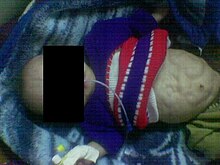Prune Belly Syndrome
| Classification according to ICD-10 | |
|---|---|
| Q79.4 | Abdominal wall aplasia syndrome |
| ICD-10 online (WHO version 2019) | |
The prune belly syndrome (PBS), also Bauchdeckenaplasie syndrome or Eagle-Barrett syndrome called, is a congenital malformation syndrome . It is characterized by a triad of symptoms consisting of a lack of abdominal muscles , severe malformations of the lower urinary tract and bilateral cryptorchidism (only in boys). Since only 1 in 40,000 newborns, 95% of them boys, are affected, it is a rare disease .
Meaning of the name and medical history
Prune-belly syndrome is a term of English origin and translates as "plum belly syndrome" or "prune belly syndrome" ( prune English for "back" or "prune" and belly for "belly"). This means the wrinkled appearance, similar to a dried plum, of the abdomen of the person affected, which is caused by the malformation of the abdominal muscles. In addition, there are some other synonyms such as Obrinsky-Fröhlich syndrome , named after Franz Fröhlich and William Obrinsky or Eagle-Barrett syndrome named after George S. Barrett and JF Eagle .
In 1839, Franz Fröhlich described the first case in which a lack of abdominal muscles was observed. However, other malformations, such as those typically found in prune belly syndrome, have not been described. In 1895, RW Parker described the case of a patient in whom, in addition to the absence of the abdominal muscles, cryptorchidism was detectable. Many other publications followed, including those by Eagle and Barrett, which described 9 cases.
frequency
The incidence of the disease in live births is between 1: 30,000 and 1: 50,000. Boys are affected much more frequently than girls. Only 3–10% of those affected are girls. There are over 200 case reports in the medical literature .
Clinical picture
The characteristic puckered belly is noticeable after birth. The puckering is caused by hypoplasia of the abdominal wall muscles. In boys, no testicles can be felt in the scrotum (cryptorchidism). The testicles are usually in the abdominal area (intra-abdominal). In addition, malformations of other organs or organ systems can be conspicuous. The skeletal system can be affected in the form of club feet , congenital joint stiffness ( arthrogryposis multiplex congenita ), hip dislocations , hip dysplasias and multiple fingers . Malformations of the gastrointestinal tract can occur, such as malrotation , anal atresia , gastroschisis and omphalocele . Other possible malformations are pulmonary dysplasia and malformations of the cardiovascular system in around 10% of cases, especially atrial and ventricular septal defects and Fallot's tetralogy .
Diagnosis
With the help of ultrasound, urinary tract dilatations and abdominal wall irregularities can be detected even before birth. Differentiating the urinary tract dilation caused by kidney dysplasia from other causes such as vesicorenal reflux or urethral valves is difficult.
root cause
The cause of prune belly syndrome is unknown. Several causes are discussed.
Individual evidence
- ^ A b Regine Witkowski, Eva Ullrich, Otto Prokop: Lexicon of Syndromes and Malformations: Causes, Genetics, Risks. Springer Verlag, 2003, ISBN 3-540-44305-3 , p. 176.
- ^ B. Leiber: The clinical syndromes. Syndromes, sequences and symptom complexes. Edited by G. Burg, J. Kunze, D. Pongratz, PG Scheurlen, A. Schinzel, J. Spranger. 7th edition. Urban & Schwarzenberg 1990, ISBN 3-541-01727-9 .
- ↑ Prune-belly-Syndrome on Urologielehrbuch.de by Dr. med. Dirk Manski, accessed on May 28, 2019
- ^ W. Obrinsky, Agenesis of abdominal muscles with associated malformation of the genitourinary tract; a clinical syndrome. In: Am J Dis Child. 1949 Mar; 77 (3), pp. 362-373. ISSN 0096-8994 . PMID 18116668 .
- ^ A b J. F. Eagle, GS Barrett: Congenital deficiency of abdominal musculature with associated genitourinary abnormalities: A syndrome. Report of 9 cases. In: Pediatrics. Volume 6, Number 5, November 1950, pp. 721-736, ISSN 0031-4005 , PMID 14797335 .
- ↑ Franz Fröhlich: The lack of muscles, especially the side abdominal muscles. Zürn 1839.
- ↑ RW Parker: Case of an Infant in whom some of the abdominal muscles were absent. Transactions of the Clinical Society of London, 1895.
- ↑ FO Adebonojo: dysplasia of the anterior abdominal musculature with multiple congenital anomalies. Prune belly or triad syndrome. In: J Natl Med Assoc. 1973 Jul; 65 (4), pp. 327-333, PMID 4269626
- ↑ Michael J Lentze, K. Heyne: Pediatrics: Basics and Practice . Springer Verlag, 2003, ISBN 3-540-43628-6 , p. 934.
- ↑ a b c Dieter Jocham, Kurt Miller: Praxis der Urologie 1. Allgemeine Urologie Georg Thieme Verlag, 2007, ISBN 978-3-13-111903-2 , p. 475.
- ↑ Hans-Ulrich Schmelz, Christoph Sparwasser, Wolfgang Weidner: Specialist knowledge of urology. Differentiated diagnosis and therapy. Springer, 2010, ISBN 978-3-642-01625-7 , p. 455.
further reading
- S. Hassett, GH Smith, AJ Holland: Prune belly syndrome. In: Pediatric surgery international. [Electronic publication before printing] December 2011, ISSN 1437-9813 , doi : 10.1007 / s00383-011-3046-6 , PMID 22198807 .
- JC Routh, L. Huang et al. a .: Contemporary epidemiology and characterization of newborn males with prune belly syndrome. In: Urology. Volume 76, Number 1, July 2010, pp. 44-48, ISSN 1527-9995 , doi : 10.1016 / j.urology.2009.12.072 , PMID 20381841 .
- AG Woods, DH Brandon: Prune belly syndrome. A focused physical assessment. In: Advances in neonatal care: official journal of the National Association of Neonatal Nurses. Volume 7, Number 3, June 2007, pp. 132-143, ISSN 1536-0903 , PMID 17844777 . (Review).
Web links
- Prune Belly Syndrome. In: Online Mendelian Inheritance in Man . (English), (English)
- Image of the abdomen of a child with prune belly syndrome on the embryology.ch website
- Illustration of a child with Prune Belly Syndrome on the Georgetown University pages
